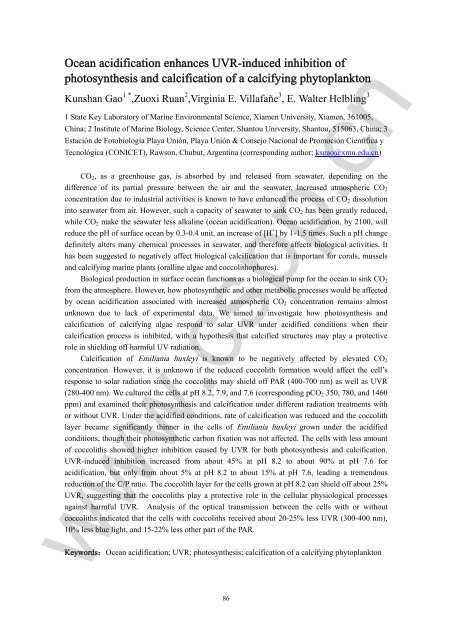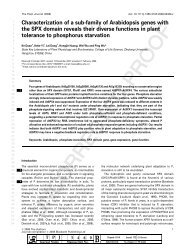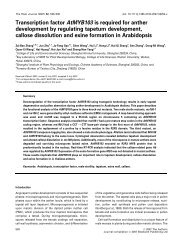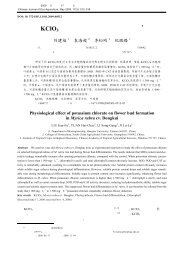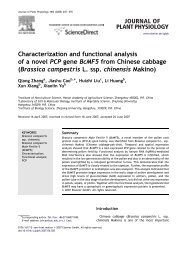Untitled - ä¸å½æ¤ç©ççä¸ååçç©å¦å¦ä¼
Untitled - ä¸å½æ¤ç©ççä¸ååçç©å¦å¦ä¼
Untitled - ä¸å½æ¤ç©ççä¸ååçç©å¦å¦ä¼
You also want an ePaper? Increase the reach of your titles
YUMPU automatically turns print PDFs into web optimized ePapers that Google loves.
Ocean acidification enhances UVR-induced inhibition of<br />
photosynthesis and calcification of a calcifying phytoplankton<br />
Kunshan Gao 1 * ,Zuoxi Ruan 2 ,Virginia E. Villafañe 3 , E. Walter Helbling 3<br />
1 State Key Laboratory of Marine Environmental Science, Xiamen University, Xiamen, 361005,<br />
China; 2 Institute of Marine Biology, Science Center, Shantou University, Shantou, 515063, China; 3<br />
Estación de Fotobiología Playa Unión, Playa Unión & Consejo Nacional de Promoción Científica y<br />
Tecnológica (CONICET), Rawson, Chubut, Argentina (corresponding author; ksgao@xmu.edu.cn)<br />
CO 2 , as a greenhouse gas, is absorbed by and released from seawater, depending on the<br />
difference of its partial pressure between the air and the seawater. Increased atmospheric CO 2<br />
concentration due to industrial activities is known to have enhanced the process of CO 2 dissolution<br />
into seawater from air. However, such a capacity of seawater to sink CO 2 has been greatly reduced,<br />
while CO 2 make the seawater less alkaline (ocean acidification). Ocean acidification, by 2100, will<br />
reduce the pH of surface ocean by 0.3-0.4 unit, an increase of [H + ] by 1-1.5 times. Such a pH change<br />
definitely alters many chemical processes in seawater, and therefore affects biological activities. It<br />
has been suggested to negatively affect biological calcification that is important for corals, mussels<br />
and calcifying marine plants (oralline algae and coccolithophores).<br />
Biological production in surface ocean functions as a biological pump for the ocean to sink CO 2<br />
from the atmosphere. However, how photosynthetic and other metabolic processes would be affected<br />
by ocean acidification associated with increased atmospheric CO 2 concentration remains almost<br />
unknown due to lack of experimental data. We aimed to investigate how photosynthesis and<br />
calcification of calcifying algae respond to solar UVR under acidified conditions when their<br />
calcification process is inhibited, with a hypothesis that calcified structures may play a protective<br />
role in shielding off harmful UV radiation.<br />
Calcification of Emiliania huxleyi is known to be negatively affected by elevated CO 2<br />
concentration. However, it is unknown if the reduced coccolith formation would affect the cell’s<br />
response to solar radiation since the coccoliths may shield off PAR (400-700 nm) as well as UVR<br />
(280-400 nm). We cultured the cells at pH 8.2, 7.9, and 7.6 (corresponding pCO 2 350, 780, and 1460<br />
ppm) and examined their photosynthesis and calcification under different radiation treatments with<br />
or without UVR. Under the acidified conditions, rate of calcification was reduced and the coccolith<br />
layer became significantly thinner in the cells of Emiliania huxleyi grown under the acidified<br />
conditions, though their photosynthetic carbon fixation was not affected. The cells with less amount<br />
of coccoliths showed higher inhibition caused by UVR for both photosynthesis and calcification.<br />
UVR-induced inhibition increased from about 45% at pH 8.2 to about 90% at pH 7.6 for<br />
acidification, but only from about 5% at pH 8.2 to about 15% at pH 7.6, leading a tremendous<br />
reduction of the C/P ratio. The coccolith layer for the cells grown at pH 8.2 can shield off about 25%<br />
UVR, suggesting that the coccoliths play a protective role in the cellular physiological processes<br />
against harmful UVR. Analysis of the optical transmission between the cells with or without<br />
coccoliths indicated that the cells with coccoliths received about 20-25% less UVR (300-400 nm),<br />
10% less blue light, and 15-22% less other part of the PAR.<br />
www.cspp.cn<br />
Keywords:Ocean acidification; UVR; photosynthesis; calcification of a calcifying phytoplankton<br />
86


